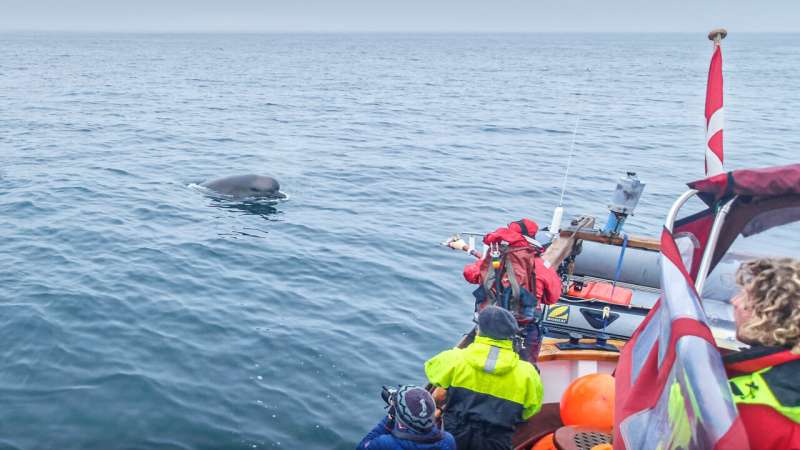A breakthrough study by a specialist European research team, including scientists at the University of St Andrews, shows man-made underwater noise pollution is picked up by whales in a similar way they sense natural predators, explaining why some species are particularly sensitive to disturbance.
The report, led by a team of behavioral ecology experts including Professor Patrick Miller and Dr. Saana Isojunno from the University's Sea Mammal Research Unit (SMRU), says cetaceans—whales, dolphins and porpoises—are faced with choosing "life over dinner" and that their responses to sounds from man-made noise such as military sonar systems are shaped by how they evolved to respond to natural predators like killer whales. While some cetaceans may be able to fight or flee from predators when they think they are under attack, underwater noise disturbance created by humans is also causing them to stop foraging and, therefore, become more vulnerable by impacting their energy budgets.
The findings were part of a project involving European colleagues, including oceanographer Dr. Frans-Peter Lam of Acoustics & Sonar at the TNO in The Netherlands; Dr. Petter Kvadsheim, Principal Scientist in Sensor and Surveillance Systems at the Norwegian Defense Research Establishment; Charlotte Curé of the Joint Research Unit in Environmental Acoustics at Cerema, University Gustave Eiffel; and SMRU Ph.D. student Eilidh Siegal, as part of the 3S (Sea mammals, Sonar and Safety) team.
The S3 research team found that navy sonar caused cessation of foraging in all four species of whale they studied—beaked northern bottlenose, humpback, sperm and long-finned pilot whales—which all rely on acoustic signals to assess predation risk as well as to find food themselves.
Professor Miller, co-lead author of the report with Dr. Isojunno, said: "The fact that whales and dolphins can be negatively affected by sonar sounds came to the attention of the public due to high profile stranding events in which large numbers of whales stranded in association with military sonar activities.
"In the early-to-mid 2000s, several different research groups, including our 3S group which authored this most recent work, established novel procedures to directly study how the behavior of free-ranging whales is affected by exposure to sonar sounds."
Since 2006 the team has documented the behavioral responses of six species of cetaceans off the cost of Norway, while other species have been studied by research groups working primarily in the U.S.
He explained that data for the latest study, obtained in the Arctic waters around Norway, shows that when marine mammals tagged with temporary transmitters were played naval sonar of 1–4 kilohertz or playback killer whale sounds, the amount of time 43 whales belonging to one of the four species spent foraging for food decreased around the same rate.
Data varies between species with beaked northern bottlenose stopping foraging completely while sperm whales showed just a 50% reduction in foraging time.
Professor Miller added: "As human activities impact virtually every animal habitat on the planet, identifying species at risk from disturbance is a priority. Measuring reduction in intense feeding activities during playbacks of killer whale sounds showed a strong correlation across species close to a 1:1 line.
"In our study, matched responses of naval sonar and predatory killer whale sound playbacks indicate that whales who are both predators and prey but rely on hearing to both find food and detect dangers have not adjusted their threat response by learning to tell the difference between noise that does not represent a predation risk from that which does.
"Effectively, they are having to choose life over dinner when they hear a potential threat in the sea. This is a particular concern for Arctic cetaceans, with both killer whales and humans increasingly able to access Arctic waters due to melting sea ice. Several Arctic marine mammals use crypsis and flight to avoid falling victim to killer whales and similar responses have been reported to ice-breaker noise and airguns used in oil and gas exploration. Our findings show that these Arctic marine mammals face a looming 'double whammy' impact of increased number of real predators as well as perceived threats from increasing human noise under the sea."
- Karlston
-

 1
1



Recommended Comments
There are no comments to display.
Join the conversation
You can post now and register later. If you have an account, sign in now to post with your account.
Note: Your post will require moderator approval before it will be visible.